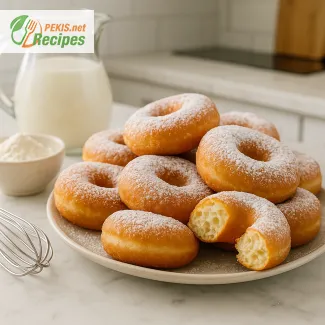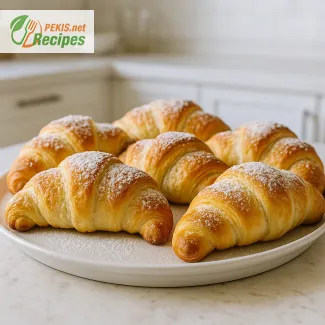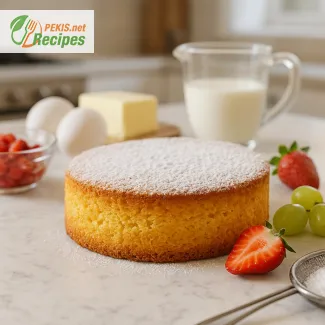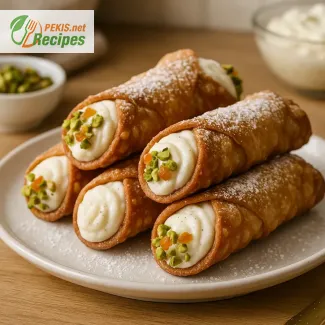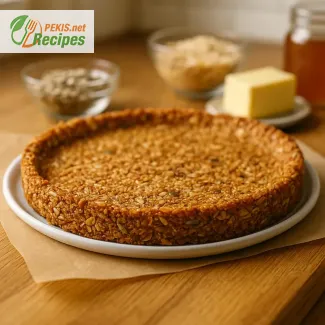Makes 12 donuts, prep 25 min, cook 15 min, total 40 min plus rising. These homemade donuts are light, fluffy, and golden with a sweet vanilla glaze that sets perfectly. Simple pantry staples like flour, milk, butter, sugar, and eggs create a tender dough enriched with yeast for airy texture. Best enjoyed warm, they keep 2 days at room temperature, freeze up to 2 months, and reheat at 150 °C for 8–10 minutes. Perfect for breakfast, dessert, or festive gatherings.
PEKIS – professional chef and recipe developer with more than 25 years of experience, specializing in European and international cuisine. I’ve worked with countless variations of doughnuts, from classic yeast-raised to modern filled and glazed creations, and this recipe captures the balance between light texture and rich flavor. Years of practice taught me how yeast, butter, and milk work together to create that signature soft crumb and golden crust, making these homemade donuts stand out as both authentic and versatile.

Perfectly Fluffy Homemade Donuts with Irresistible Glaze
The golden charm of freshly made doughnuts
Golden-brown on the outside, pillowy and soft on the inside, homemade donuts bring the irresistible aroma of warm yeast dough straight into your kitchen. Light yet indulgent, they combine the comforting richness of butter, the gentle sweetness of sugar, and the delicate lift of yeast to create a treat that feels both nostalgic and freshly exciting. Glazed to a shining finish or left simple with a dusting of powdered sugar, these doughnuts capture the essence of true comfort baking.
Origins and cultural roots of doughnuts
The story of doughnuts dates back centuries, with traces of fried dough recipes found in Europe and America long before the iconic ring shape became standard. Dutch settlers are believed to have introduced their “olykoeks” (oily cakes) to the United States, where they evolved into the modern donut. The familiar round form with a hole in the middle was popularized in the 19th century as a way to ensure even frying, and soon these fluffy treats became a staple of American bakeries and coffee shops. Over time, donuts spread across the world, adapting to local flavors while preserving their core appeal: a golden crust, tender crumb, and a glaze that makes them shine.
Why you’ll love this recipe
- Soft and fluffy texture with every bite
- Classic glaze that enhances sweetness without overpowering
- Homemade comfort with simple ingredients
- Versatile dough that can be filled, topped, or frosted
- Perfect for sharing on any occasion
Key elements that make donuts irresistible
The secret behind a truly great donut lies in the balance of ingredients and techniques:
- Flour provides the structure while still keeping the crumb delicate.
- Yeast adds lightness, creating tiny air pockets that make each bite airy.
- Butter and milk enrich the dough, contributing tenderness and flavor.
- Sugar not only sweetens but also helps with browning and a soft crust.
- Glaze or toppings transform the donuts into endless variations, from classic vanilla glaze to chocolate drizzle or festive sprinkles.
Creative variations to try
Homemade donuts are a canvas for endless creativity. Once the basic dough is mastered, it can be transformed into countless flavors:
- Cinnamon sugar donuts rolled in spiced sugar for a warming twist.
- Filled donuts with custard, jam, or chocolate cream at the center.
- Maple glazed donuts topped with crunchy bacon for a sweet-salty combination.
- Seasonal donuts using pumpkin puree, apple cider, or festive sprinkles.
- Mini donuts for parties and quick bites.
Storing and preparing in advance
Homemade donuts are best enjoyed fresh, but they can be prepared ahead and stored:
- At room temperature: Keep in an airtight container for up to 2 days.
- For freezing: Store in a sealed bag or container for up to 2 months.
- For reheating: Warm in the oven at 150 °C (300 °F) for 8–10 minutes to restore softness.
Culinary context and serving ideas
Freshly fried donuts are traditionally served in the morning, paired with coffee, tea, or hot chocolate, but they also make a delightful dessert or party centerpiece. Whether you enjoy them with a classic vanilla glaze, dipped in melted chocolate, or decorated with colorful sprinkles, they bring a sense of joy and indulgence. Donuts have also become a popular choice for festive gatherings, weddings, and brunches, often displayed in creative towers or arranged on donut walls to impress guests.
Donuts as a timeless indulgence
What makes donuts so enduring is their universal charm: they are both simple and luxurious, easy to adapt yet consistently satisfying. The combination of golden crust, airy center, and sweet glaze makes them a beloved treat across cultures and generations. Every bite carries a touch of tradition and a spark of creativity, making homemade donuts an experience worth repeating.
- Warm the milk gently until lukewarm, then stir in yeast and a teaspoon of sugar. Let it sit for 5–10 minutes until foamy.
- In a large bowl, combine flour, remaining sugar, and salt. Add the yeast mixture, eggs, softened butter, and vanilla extract. Knead until a soft, elastic dough forms.
- Cover the bowl with a cloth and let the dough rise in a warm place for 1–2 hours, or until doubled in size.
- Roll the dough to about 1.5 cm thickness and cut out circles with a donut cutter (or round cutter plus smaller one for the center).
- Place the shaped donuts on parchment paper, cover lightly, and let rise again for 30–40 minutes.
- Heat vegetable oil to 175 °C (350 °F). Fry donuts in small batches for 1–2 minutes per side, until golden brown. Transfer to a paper towel-lined plate to drain excess oil.
- For the glaze, whisk together powdered sugar, milk, and vanilla extract until smooth. Dip warm donuts into glaze, allowing excess to drip off. Place on a rack to set.
FAQ questionHow do I make donuts soft and fluffy, not dense?
Aim for a well-aerated, enriched dough and gentle handling. Use active dry yeast that’s fresh (it should foam in lukewarm milk within 5–10 minutes), knead until the dough is smooth and elastic (light windowpane), and keep dough temperature around 24–26 °C. Let the dough rise until doubled in a warm, draft-free spot, then shape and proof again until puffy and slightly jiggly. Over-flouring or under-proofing leads to dense results; proper proofing ensures that soft, airy crumb.
FAQ questionCan I bake donuts instead of frying?
Yes—baked “donuts” will be lighter and bread-like, not quite the same as fried. Pipe or cut rings, proof until puffy, then bake at 190 °C (375 °F) until lightly golden. Brush with melted butter while warm and finish with cinnamon sugar or a thin vanilla glaze. For a closer fried texture, use a slightly richer dough and avoid over-baking; the goal is a tender, moist interior.
FAQ questionWhat oil and temperature are best for frying donuts?
Choose a neutral, high-smoke-point oil (canola, sunflower, refined peanut). Maintain 175 °C (350 °F) for even browning and minimal grease absorption. If oil runs cool, donuts soak up oil; if too hot, they brown before cooking through. Fry in small batches, turning once, and let each donut rest on a rack to drain and stay crisp-tender.
FAQ questionWhy didn’t my dough rise, and how can I fix it?
Likely culprits are inactive yeast, milk that’s too hot or too cold, or a room that’s too cool. Verify yeast viability (it should foam with a pinch of sugar), warm your environment (slightly above 24 °C helps), and give the dough time—1–2 hours for bulk rise, 30–40 minutes after shaping. If the dough is tight, rest it to relax gluten; if it’s very slack, a brief cold chill can make shaping easier. The fix is patience plus consistent, gentle warmth.
FAQ questionHow do I make a glaze that sets shiny and smooth?
Use sifted powdered sugar, a touch of vanilla, and enough milk to reach a pourable, ribboning consistency. Dip warm donuts so the glaze melts into a thin, even coat, then set on a rack for that classic glossy finish. For chocolate, whisk in cocoa powder; for extra sheen, add a small amount of light corn syrup. Keep the glaze lump-free and fluid, not thick and pasty.
FAQ questionCan I make the dough ahead and freeze donuts?
Absolutely. Do an overnight cold rise (covered, 8–12 hours) for deeper flavor and easier scheduling. Shaped, un-fried donuts can be frozen on a tray, then bagged; thaw in the fridge and proof until light and puffy before frying. Fried donuts keep 2 days at room temperature, freeze up to 2 months, and reheat at 150 °C (300 °F) for 8–10 minutes to refresh the soft, fluffy texture.
Golden, airy, and lightly glazed, homemade donuts bring together everything people love about classic baking traditions and modern creativity. The combination of soft dough, gentle sweetness, and a delicate vanilla glaze creates a treat that feels both nostalgic and timeless. Each bite offers that satisfying contrast between a crisp golden exterior and a pillowy interior, making them perfect for mornings, celebrations, or indulgent afternoon snacks.
The process of preparing donuts highlights the beauty of working with yeast dough, where patience and technique turn simple ingredients into something extraordinary. Allowing the dough to rise properly ensures the signature fluffy texture, while frying at the right temperature gives the donuts their golden finish without greasiness. The glaze, smooth and shiny, seals in flavor and adds just the right amount of sweetness.
What makes donuts so enduring is their adaptability. They can be rolled in cinnamon sugar, filled with jam or custard, or topped with festive sprinkles. Each variation keeps the foundation of a soft and airy donut while opening the door to endless flavor possibilities. From classic breakfast tables to elegant dessert spreads, they remain a versatile choice for all occasions.
The ability to store and reheat donuts extends their appeal beyond the moment they’re fried. With careful freezing and quick reheating, these fluffy donuts can be enjoyed fresh even days or weeks later. This balance of tradition, convenience, and creativity makes homemade donuts a staple that continues to delight across generations.
Allergens present in the recipe:
- Gluten (flour)
- Dairy (milk, butter)
- Eggs
Substitution tips to remove allergens:
- Replace wheat flour with a gluten-free flour blend suitable for yeast doughs.
- Use plant-based milk (soy, almond, oat) instead of cow’s milk.
- Substitute butter with margarine or coconut oil.
- Replace eggs with applesauce (50 g per egg) or flaxseed gel (1 tbsp flaxseed meal + 3 tbsp water per egg).
- Vitamin A: 90 µg – supports vision and immune function
- Vitamin B2 (Riboflavin): 0.15 mg – contributes to energy metabolism
- Vitamin B12: 0.2 µg – important for nervous system health
- Vitamin D: 0.3 µg – supports bone health
- Calcium: 45 mg – helps maintain strong bones and teeth
- Iron: 1.5 mg – essential for oxygen transport in the blood
- Magnesium: 12 mg – supports muscle and nerve function
- Potassium: 115 mg – important for fluid balance and heart health
- Vitamin E: 0.4 mg – protects cells from oxidative stress
- Selenium: 6 µg – supports immune defense and antioxidant function
- Phenolic compounds from vanilla extract – mild antioxidant effect
